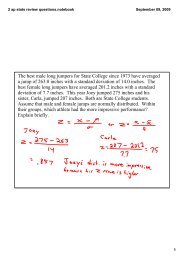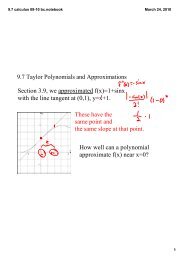Methods of Indirect Measurement Common angle method using ...
Methods of Indirect Measurement Common angle method using ...
Methods of Indirect Measurement Common angle method using ...
Create successful ePaper yourself
Turn your PDF publications into a flip-book with our unique Google optimized e-Paper software.
In the problem that follows, ignore the fact that the entire ride is set at an <strong>angle</strong> to the<br />
horizontal. Consider the ride as if it were running in a horizontal manner. This is a place<br />
where your expertise in calculus will shine through. Good luck.<br />
PROBLEM<br />
(1) Given the rotation speed and the radius <strong>of</strong> the car cluster, write an equation to<br />
describe the position vs. time for an individual car in the frame <strong>of</strong> reference <strong>of</strong><br />
the car cluster.<br />
(2) Given the rotation speed and the radius <strong>of</strong> the car cluster on the total ride<br />
platform, write an equation to describe the ride position vs. time for a car cluster<br />
in the frame <strong>of</strong> reference <strong>of</strong> the stationary ground.<br />
(3) Add the results <strong>of</strong> your two equations to predict the overall position vs. time <strong>of</strong><br />
an individual car relative to the stationary ground. [This can be plotted on a<br />
graphing calculator if you have one with you. Hint: polar coordinates.]<br />
(4) Write the overall velocity vs. time equation for an individual car relative to the<br />
stationary ground.<br />
(5) Find the maximum and minimum accelerations (dv/dt) <strong>of</strong> an individual car as<br />
predicted by your equation.<br />
(6) Finally, compare your measured results with the calculated values.






